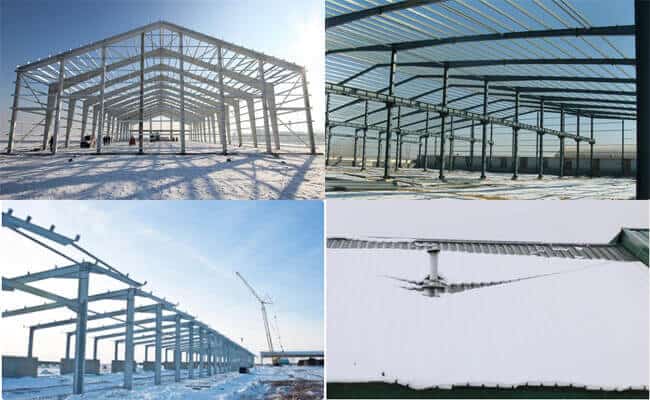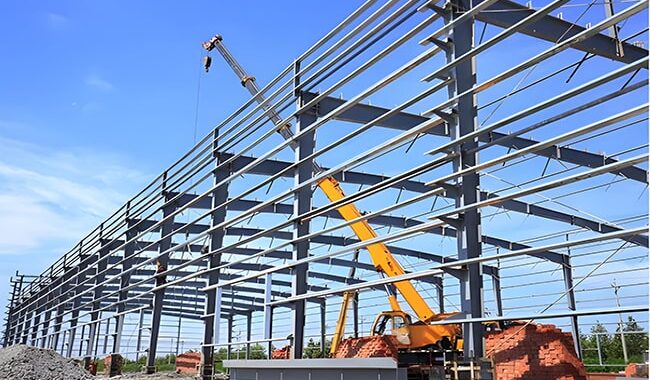In the construction of modern storage facilities, steel structure warehouses have become one of the mainstream building forms due to…
Snow load refers to the snow pressure exerted by snow on the roof of a building no matter how cold the winter is. The buildings that collapse in heavy snowfall are mainly steel structures, such as factories, greenhouses, gas stations, canteens, membrane structures, etc. The harm of snow load to steel structures primarily refers to the impact of snow load on the safety and stability of steel structures. Because the snow is not only “frozen” but also “heavy”.

The harm of snow load to steel structure:
After a heavy snowstorm, steel structures and buildings are seriously covered with snow. If the snow load is overloaded, it will cause safety hazards. For example, in a steel structure building, the roof purlins may deform due to overloading due to snow load. When the purlins become unstable, the tie rod and fly bracing systems cannot provide good support, leading to potential risks such as structural instability.
The harm of snow load to steel structures may lead to collapse accidents. Reasons include insufficient consideration of snow loads in the early stages of design, inadequate consideration of fatigue damage to steel structures, lack of maintenance, and other factors such as component manufacturing quality, construction quality, and installation issues. To ensure the safety of steel structure buildings, it is necessary to strengthen management and control in design, construction, and maintenance, especially in snow load; the actual situation and regional characteristics must be fully considered to ensure that it can withstand the pressure of snow.
How much does snow weigh? Let’s look at precipitation and snow depth.
Snowflakes are not heavy; 5,000 to 10,000 snowflakes weigh only 1 gram. However, when it snows continuously, snowflakes will continue to gather. One cubic meter of new snow comprises 6 billion to 8 billion pieces of snow. Its specific weight is difficult to calculate in grams. The vast weight generated is enough to crush the snow, fallen trees, and buildings.

Precipitation:
It refers to the value measured in millimeters by meteorological observers after using a standard container to turn snow collected within 12 or 24 hours into water.
Snow depth:
The snow thickness we usually see is the vertical distance from the snow surface to the ground, measured in millimeters.
Under normal circumstances, how much snow can be accumulated by one millimeter of snowfall is related to factors such as ground temperature and the moisture content in the snow. If the ground temperature is high, the snow will melt immediately when it hits the ground, and snow will not form; if the water content in the snow is high, the snow will be relatively thin, and if the water content is low, the snow will be pretty deep.
Data show that under normal circumstances, 1 mm of precipitation equals 8 to 10 mm of snow in the north and 6 to 8 mm in the south. This is mainly because the snow content in the north is The amount of water is lower than in the south.
If the snow load of your house is 0.5 kN per square meter, then it is equivalent to your roof being able to withstand 50 kilograms of snow per square meter. If calculated based on the volume of water, each square meter can withstand about 0.5 meters of water, and the mass of water must be much greater than that of snow. Therefore, the house can withstand more than 0.5 meters of snow per square meter. As for how much larger it is, it depends on snow density.
Snow can be divided into dry snow and wet snow. Their densities are different, and their masses of the same volume are naturally also different.
Dry snow:
When snowflakes fall, the temperature of each air layer is always below 0°C, which allows them to drop to the ground in the shape of snowflakes, forming “dry snow.” Dry snow has a low moisture content, and the gaps in the snow are filled with air. The mass of the same volume is relatively light, but dry snow is not easy to melt and can quickly form snow. In some areas in northern my country, the snow accumulation can reach 60 to 70cm. Under continuous snowfall, the lower layer of snow is continuously squeezed by gravity, becoming increasingly dense and heavy.
Wet snow:
After passing through a warm layer during the falling process, frozen snowflakes tend to be moist and melt, thus forming damp snow.
As the name suggests, wet snow has a relatively high moisture content and can clump together with your hands. Therefore, under the same volume, the weight of wet snow is somewhat heavier.
The adhesion of damp snow is small, and it is challenging to form snow. However, the wet snow will freeze on the object if the snow falls heavily enough. The ice will appear in white accumulation, and the melted water will fill the gaps in the snow. Accumulate weight quickly.
If the density of new snow is about 0.05 to 0.1 grams per m³, then a flat roof of 100㎡ with a snow thickness of 20cm will bear a weight of 1 to 2 tons.

Snow Load to Steel Structure: steel buildings collapse under heavy snow
1. The snow load is not fully considered at the beginning of the design.
If the snow load to the steel structure is underestimated during the design process, the load will not meet the snow resistance requirements. Snow load is a professional term in construction that refers to the snow pressure acting on the top surface of a building or structure, that is, the gravity of the snow acting on the building.
It depends on the snow’s depth and unit volume weight. The value of the snow load is directly related to how much snow our metal buildings can withstand. The snow load to steel structures in China is usually designed based on the maximum snow pressure in the past 50 years. However, in the actual statistical process, due to incomplete snow density data, the snow pressure value can only be estimated based on the average density, which results in the fundamental snow pressure value being smaller than the actual snow pressure value.
2. Lack of adequate consideration of fatigue damage of steel structures.
Steel structures have the advantages of being lightweight, high strength, good earthquake and wind resistance, short construction period, energy saving, and environmental protection, so they are widely used in industrial and agricultural construction.
With the continuous development of the manufacturing industry, steel structures, factory buildings, and greenhouses, construction is also developing towards large spans and large areas. However, if the span is large and the fatigue damage of the steel structure is not fully considered, the bearing capacity of the snow load to steel structure will decrease under long-term load, leading to snow-crushing the steel structure. Accidents in structural plants often occur.
3. The steel structure building lacks maintenance.
The decrease in the bearing capacity of snow load to steel structure is often caused by the lack of proper factory maintenance during long-term use. Since the steel structure has the disadvantage that the components easily corrode, if the steel structure building is rusted, it will not be taken seriously, and rust will be allowed to occur.
The scope continues to expand, destroying the stability of the steel structure. How can defective factories and greenhouses face heavy snow weather? Therefore, to ensure the durability of steel structure buildings, we cannot promptly ignore their daily maintenance and eliminate safety hazards. When encountering heavy snow weather, If the snow is too thick and the snow is not cleared in time, steel structure building collapse accidents may quickly occur.
The harm of snow load to steel structure: Other factors.
1. Many factors lead to the collapse of steel buildings due to snow.
In addition to the fact that the design does not fully consider the fatigue damage of the steel structure and the lack of regular maintenance of the factory building based on the actual situation and region, it is also related to the manufacturing quality and construction methods of the steel structure manufacturers’ components. It is linked to factors such as the quality of construction, whether the material selection is reasonable, and whether the quality is up to standard.
2. On-site installation of steel structures is also a top priority.
Some installation units were not constructed according to the design during the installation process, and the support system was not built as required: for example, corner braces, horizontal braces, purlin tie rods, etc., were not tensioned, and snow was encountered. Excessive thickness causes structural instability and collapse.
3. The construction workers are unprofessional.
Some steel structure buildings, temporary work sheds, vegetable market roofs, etc. Generally, they hire steel structure installation contractors from the society. They have no relevant qualifications and have no design calculations. They only rely on their own experience to process and install the structures. , this kind of structure is also the main target of heavy snow.
In conclusion
To ensure the safety and stability of steel structure buildings, it is necessary to strengthen management and control in design, construction, and maintenance. Especially in snow load, full consideration must be given to actual conditions and regional characteristics to ensure that it can withstand the pressure of snow accumulation. At the same time, it is necessary to strengthen steel building maintenance and upkeep and promptly eliminate safety hazards. Other factors must also be fully considered and processed to ensure the safety and stability of steel structure buildings.














